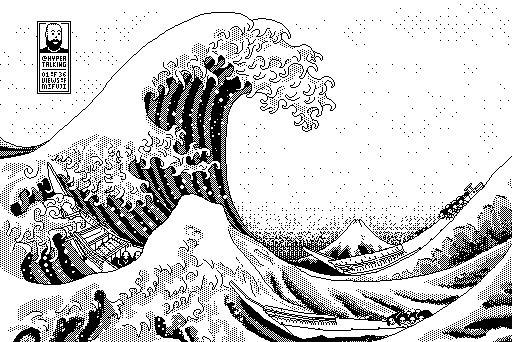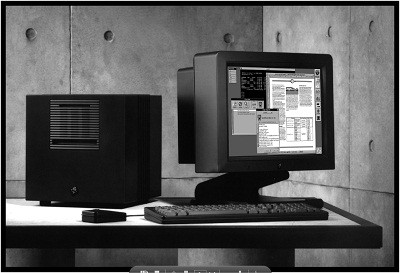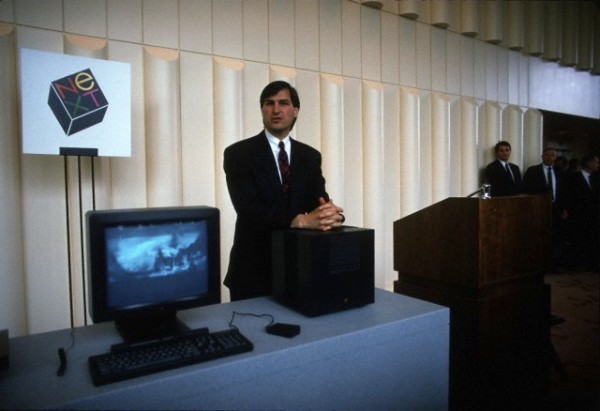Some art and history for you
Let’s start with art because art and culture are the best way to pause and relax, stretch your brain a little.
The Great Wave off Kanagawa
James Weiner creates his site “Hypertalking” in the beautiful minimalistic aesthetics of a classic Macintosh. On May 8th, he shared his work on recreating the classic Hokusai painting in the classic Macintosh graphics format – 512×342px, 1-bit depth (meaning only black and white pixels are available).

This masterpiece was created using an image editor originating in 1986, and last updated in 1993, which makes the latest version really mature ;-). Want to know which one, and grab a version for 640×480 desktop background? See James’s post – 1-bit Hokusai’s “The Great Wave”!
Graphic card history and museum
In the PC world, the graphics card, also known as a video card, is traditionally a separate and replaceable component. It’s been like this since 1981 when the MDA and CGA (Monochrome/Color Graphics Adapter) were introduced.
There is a website aiming to collect not only their specs, but also pictures and drivers – it’s the Videocard virtual museum, and currently goes back as far as a Diamond Viper PCI (Weitek Power 9000) – no ISA cards cataloged yet.
NeXT World
If the name sounds like another virtual reality or physics breakthrough to you, then you might be missing an important part of computer history.
In 1985, Steve Jobs resigned from Apple, and started another company – NeXT.
Just 18 months have passed since the now-famous commercial that compared IBM to Orwell’s Big Brother aired during one of the biggest sports events in the USA. The ad’s menacing and dystopian tone set it apart from the other, more lighthearted ads that aired alongside it.
Back in 1988, Steve Jobs was busy working on his latest and greatest project: a “next generation” computer. But when he wasn’t tinkering with circuits and code, he was dabbling in the world of computer graphics. And get this: he’s the one who came up with the Pixar brand! That was back in ’86, when he bought the Industrial Light and Magic company from the folks who created visual effects for Star Wars, Raiders of the Lost Ark, and E.T. Pretty cool, huh?
The effect of the computer part of work was, most notably, the NeXTcube computer.


The company existed for 8 years until it merged back with Apple in 1996. It was in fact Apple who was looking for the new game changer and acquired the NeXT company for $400M.
NeXT computers were equipped with an operating system called NeXTstep. Not only did the name have a certain charm to it, but the OS itself was a great alternative to Windows. Despite being developed in 1988, NeXTstep boasted features that are still relevant today. For example, it had a Unix core, a graphical desktop, and Adobe Postscript-based font rendering – all of which might sound familiar to users of modern-day macOS.
The system also gave us the first-ever web browser, and the first-ever app store.
To explore further:
- A great timeline of Steve Jobs’s achievements and how and when NeXT came to be is featured as an example of… usage of a timeline wordpress plugin: Timeline – Ultimate Addons for WPBakery Page Builder (brainstormforce.com)
- Want to buy your own NeXTcube? Welcome to Black Hole, Incorporated (blackholeinc.com)
- NeXTComputers.org seeks to contact former NeXT employees! Welcome To The NeXT World (nextcomputers.org)
“Based on Unix” in 1988? How old is Unix?
That’s a great question! It began with Multics.
Multics (Multiplexed Information and Computing Service) was a time-sharing computer system project that began in 1965 as a joint venture between MIT, General Electric, and Bell Labs. It aimed to create a community computing facility by making the system modular, fault-free, and capable of supporting hundreds of users. Multics was not simply intended as a replacement for the overloaded CTSS (Compatible Time-Sharing System) previously developed at MIT, but it was meant to go beyond time-sharing to create a new standard for the computer as a utility. The system itself was going to be written in PL/I (Programming Language One) and assembly. The development of the PL/I compiler was contracted out to Digitek, and while waiting for the compiler to come back, the design of Multics was laid out in the Multics System Programmer’s Manual (MSPM).
However, the project began to fall behind schedule, threatening the intermediate funding being provided by the Cambridge Project, an ARPA-funded political science computing project. Concern over the extent of the software problems soon became widespread, and as early as 1967, there existed growing doubts about the future of Multics. Sam Morgan, director of Computing Science Research at Bell Labs during this period, expressed his concerns that Multics research was going very slowly and wasting effort. In fact, to the entire labs computing community, the failure of Multics to deliver promptly any sort of usable system was increasingly obvious.
As a result, Bell Labs pulled out of the project in March 1969, leaving GE and MIT to salvage what they could of the system. Doug McIlroy and Bob Morris took it upon themselves to create a backup for the system by using EPL/I (early PL/I) to write a compiler which produced output in EPL Bootstrap Assembler. This was not only very slow in compiling but was also limiting in the features that could be implemented using it.
After Bell Labs left the Multics project, Unix was born, with a similar goal of making it the most advanced time-sharing computer system yet available. Bell Labs brought with it numerous important ideas from Multics that would later serve to define Unix. The two main programmers of Unix, Ken Thompson and Dennis Ritchie, were originally on Multics team as well, therefore having the first-hand experience.
Furthermore, Bell Labs created an environment of creativity and independent thought which was integral to Unix development. The first version of Unix was written in C and assembly language in 1969-1971, and the first edition of the Unix Programmer’s Manual was published in November of that year. Unix quickly gained popularity within Bell Labs and was eventually released to other organizations. The world has heard of it for the first time in 1973.
By the early 80s it was already seen as potentially the universal operating system, suitable for home computers just as well as highly concurrent and multi-user mainframes.
Want to read more, as seen from the inside? Someone recently found a great “oral history of Unix” laying on Princeton’s University servers. Think of it as of your next ebook to read.


Wow, the oral history of Unix was actually deleted from the server quickly afterwards. I can share a backup once I find out why it happened.
[…] fatal disease”– belongs more to the problem set than to the solution set.” (remember? PL/I was the language behind Multics, a project that – by failing to meet the schedu…) or, much harder, “The use of COBOL cripples the mind; its teaching should, therefore, be […]